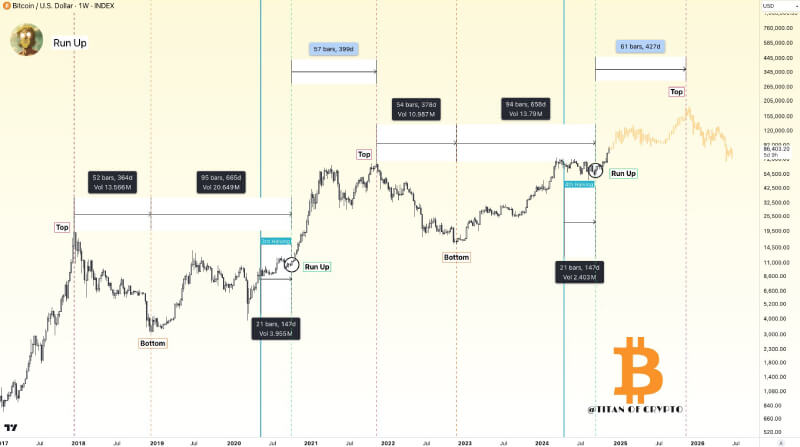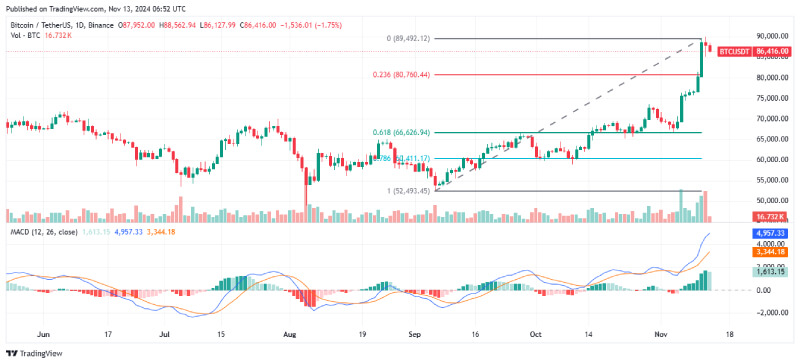- Bitcoin’s 4th halving could fuel a fresh rally, with analyst projecting a potential peak within the next 427 days.
- Post-halving patterns reveal cyclical “tops” and “bottoms,” with price momentum often slowing into consolidation before fresh highs.
- Key support at $80,760 and resistance at $89,492 are pivotal; breaking above resistance could see BTC testing levels near $90,000.
According to market analyst Washigorira, Bitcoin’s performance is closely tied to cyclical trends, driven largely by halving events. According to his analysis, Bitcoin’s price could see continued bullish momentum through the end of the year. However, a consolidation period may set in, followed by a correction. This cycle, he notes, could ultimately peak by late 2025, mirroring historical patterns.
The Halving Effect on Bitcoin’s Cycles
Bitcoin halving events, which halve the rewards for miners approximately every four years, are generally seen as catalysts for price increases. This year’s 4th halving in 2024 is a pivotal point, as previous halvings have triggered notable “run-up” periods.

After the 3rd halving in May 2020, Bitcoin experienced a sharp increase in value over 21 weekly bars (or 147 days), eventually reaching new highs. Similarly, Washigorira suggests another bullish period after the recent 4th halving, with Bitcoin potentially reaching a new peak within 427 days.
These post-halving run-ups tend to precede market tops, typically followed by corrections or consolidation phases. Observing these cycles offers insights into Bitcoin’s potential path, emphasizing a repetitive sequence of rising prices, market tops, and eventual downturns.
Price Tops, Bottoms, and Volume Analysis
Washigorira’s review further highlights Bitcoin’s recurring “tops” and “bottoms,” which mark the end of bullish runs and the beginning of market corrections, respectively. For example, after Bitcoin’s peak in 2021, a downward trend ensued, leading to a market bottom around 2022. Following this phase, Bitcoin entered another upward trend, characteristic of the cyclical nature of the cryptocurrency.
Volume analysis provides additional context, revealing heightened trading activity during key tops and bottoms. During Bitcoin’s 2021 top, trading volume spiked to approximately 20.649 million, while the subsequent 2022 bottom saw volume around 13.79 million. This recurring surge in volume during tops and bottoms underscores investor behavior patterns, with higher buying or selling pressure marking these critical price points.
Fibonacci Levels and Resistance
On the BTC/USDT daily chart, recent price movements suggest a bullish structure with Fibonacci retracement levels highlighting key support and resistance points. At press time, Bitcoin was trading at $86,416, just below a significant resistance level at $89,492. Should Bitcoin break above this, it may target psychological levels, notably near $90,000.

Fibonacci levels also indicate potential retracement targets. The 0.236 level, at $80,760, serves as an immediate downside target, while the 0.618 level at $66,626 is a stronger mid-term support.
Additionally, the MACD indicator shows the blue line above the orange signal line, signaling ongoing bullish momentum. However, a minor weakening in this indicator suggests possible consolidation or a brief pullback phase.
If Bitcoin holds its current support levels, its upward trajectory could resume. Alternatively, failure to hold the 0.236 Fib level may prompt a deeper correction.





